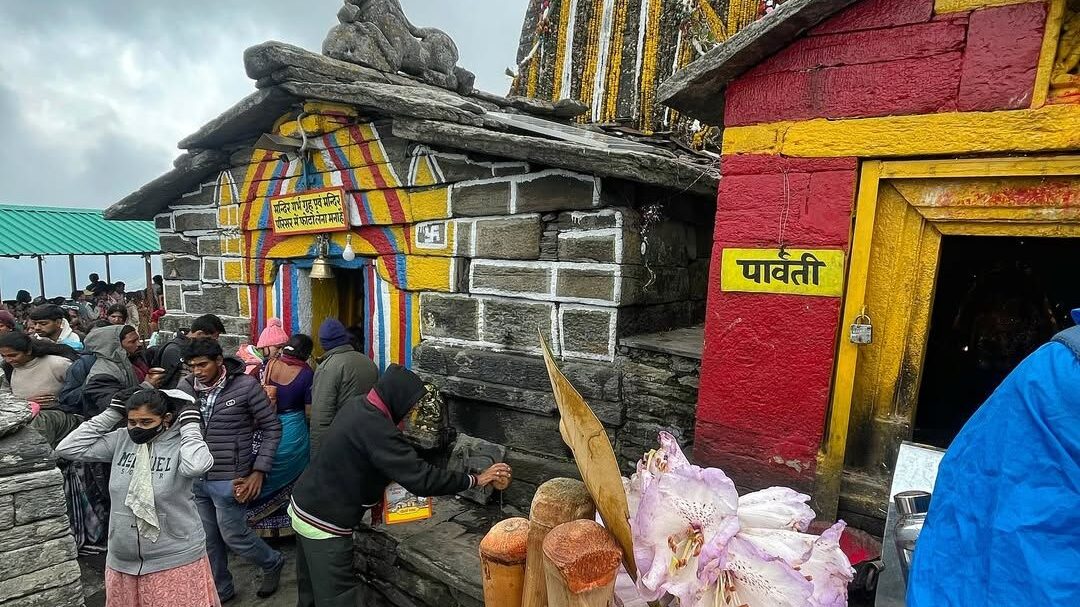Tungnath Temple: The Highest Shiva Temple in the World
Published on July 22, 2025
Tungnath Temple Trek is an extraordinary journey to the world's highest Shiva temple, located majestically in the Rudraprayag district of Uttarakhand. It stands at an elevation of 3,680 meters (12,073 feet), and this ancient shrine holds immense spiritual significance as one of the Panch Kedar temples, where Lord Shiva's arms are believed to have appeared. The trek itself is a captivating experience, starting from the picturesque meadows of Chopta and winding through dense deodar and rhododendron forests. It offers not just a pilgrimage but also breathtaking panoramic views of the towering Himalayan peaks, making it a favorite for both devotees and adventure seekers. The serene atmosphere and stunning landscapes make the Tungnath Temple trek a truly unforgettable spiritual and natural escape.
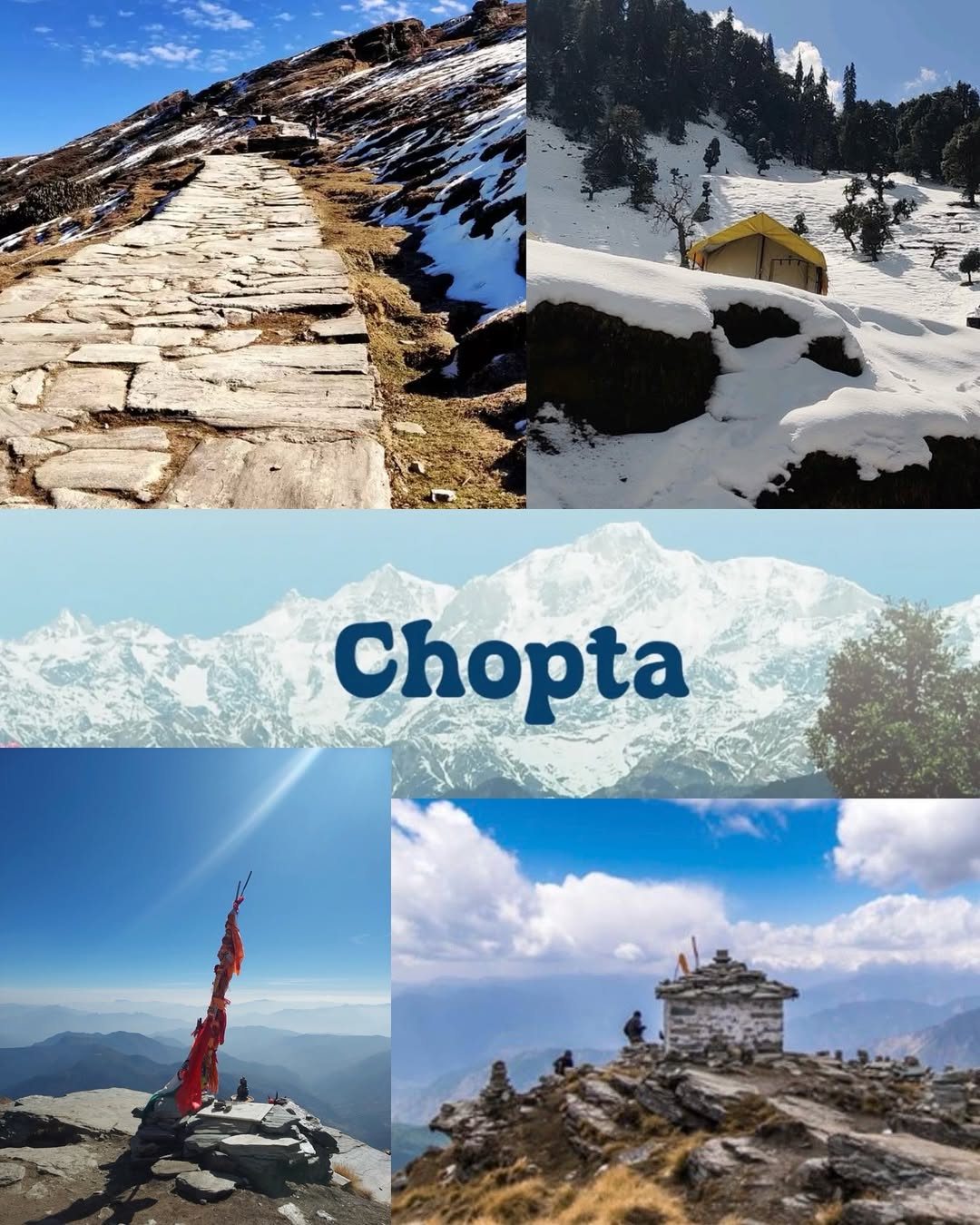
3-Day Itinerary for the Chopta Tungnath Trek & Temple Visit
Day 0: Delhi to Rishikesh to Sari Village
- Departure: Start your journey from Botanical Garden Metro Station at 10:00 PM.
- Overnight Journey: Travel overnight towards Sari Village via Rishikesh.
- Stop at Devprayag: Witness the mesmerizing confluence of the Bhagirathi and Alaknanda rivers along the way.
Day 1: Sari Village to Deoriatal
- Arrival at Sari Village: Check into your homestay and take some time to freshen up.
- Trek to Deoriatal: Begin your trek to Deoriatal (2.5 km, approximately 1.5–2 hours).
- Enjoy Deoriatal: Soak in the serene beauty of the lake and the surrounding landscapes.
- Return to Sari Village: Head back to Sari Village and enjoy a peaceful evening.
Day 2: Sari Village to Tungnath & Chandrashila
- Breakfast: Start your day with a hearty breakfast at your homestay.
- Drive to Chopta: A scenic drive of about 1 hour from Sari Village.
- Trek to Tungnath Temple: Embark on a 3.5 km trek to the sacred Tungnath Temple.
- Summit Chandrashila: Extend your trek by 1.5 km to reach the breathtaking Chandrashila summit.
- Return to Chopta/Sari: After the trek, return to Chopta or Sari for an overnight stay at the campsite.
Day 3: Chopta to Delhi
- Breakfast: Enjoy an early breakfast at your campsite in Chopta.
- Departure: Begin your journey back to Delhi in the early morning.
- Visit Dhari Devi Temple: Stop by the revered Dhari Devi Temple en route.
- Arrival in Delhi: A long drive of approximately 10–12 hours marks the end of your adventure.
Inclusion
-
One Night Accommodation In Sari Village.
-
One Night Accommodation In Chopta/Sari Village.
-
4 Meals Will Be Provided Throughtout The Trip.
-
AC Transportation.
-
Guide While trekking.
-
Experienced Trip Captain Throught The Trip.
Exclusion
-
5% GST
-
Extra Drinks, Food, Tea and Snacks.
-
Tickets for any sightseeing or extra activity outside the camp area.
-
Travel Insurance and other benefits.
-
Anything which is not mentioned in inclusions.
-
Cost escalation due to any unforeseen reason like weather, road condition landslide etc.
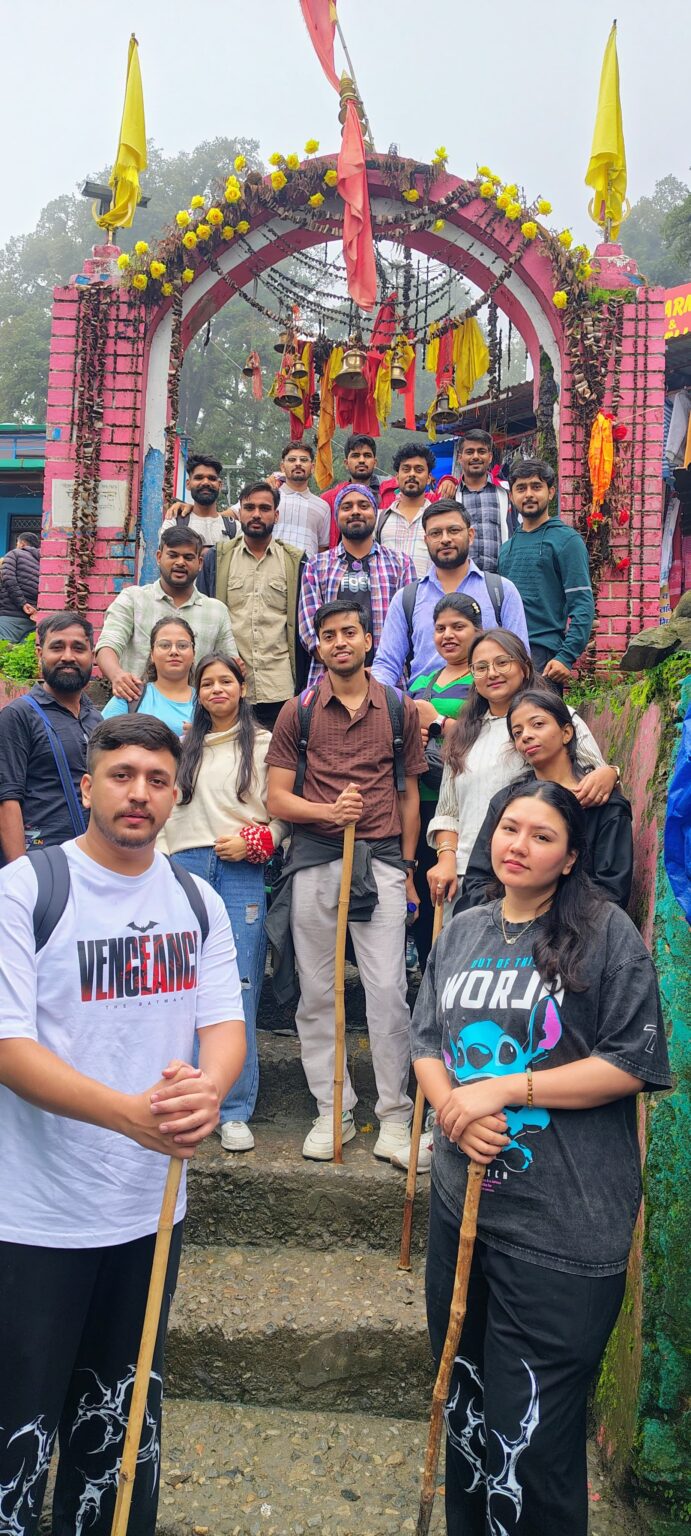
Tungnath Temple – Where Devotion Touches the Sky
Tungnath Temple stands as a testament to deep devotion and ancient beliefs, reaching towards the heavens in the majestic Himalayas. It is known as the highest Shiva temple in the world, located at an impressive height of 3,680 meters (12,073 feet) in Uttarakhand's Rudraprayag district. This sacred site is not just a place of worship but a challenging yet rewarding journey for pilgrims and adventurers alike. The spiritual energy here is immense, deeply rooted in Hindu mythology, particularly the tales of the Pandavas from the Mahabharata, who are believed to have built the temple to seek Lord Shiva's blessings after the Kurukshetra war. Tungnath is considered the place where Lord Shiva's "arms" appeared in his bull form, making it a significant part of the Panch Kedar pilgrimage circuit.
The journey to this divine abode is an experience in itself. The chopta tungnath trek is renowned for its breathtaking beauty and relatively manageable difficulty, making it accessible to many.
-
The Trek Experience:
-
Starting Point: The tungnath temple trek typically begins from Chopta, a charming meadow known for its lush greenery and stunning views.
-
Scenic Path: The path is well-laid with stones, winding through dense forests of deodar, pine, and vibrant rhododendrons. During spring, these flowers paint the landscape in beautiful hues of red and pink.
-
Moderate Difficulty: While it's an uphill climb, the trek is considered moderate, allowing most people with average fitness levels to complete it. It typically takes about 3-4 hours one way from Chopta.
-
Panoramic Views: As you go higher, you're constantly treated to sweeping panoramic views of the Garhwal Himalayas, including famous peaks like Nanda Devi, Trishul, and Chaukhamba. The air becomes crisper, and the quietness of the mountains is truly captivating.
-
-
Spiritual Significance and Surroundings:
-
Highest Shiva Temple: The sheer height of Tungnath adds to its spiritual feeling, making pilgrims feel closer to the divine.
-
Ancient Architecture: The temple itself is a simple yet ancient stone building, showing the traditional North Indian style of architecture. Its old stones tell stories of centuries of devotion.
-
Chandrashila Peak: Just a short, steeper climb from Tungnath Temple is Chandrashila Peak. From here, you get a 360-degree view of the entire Himalayan range. It's believed that Lord Rama meditated here after defeating Ravana.
-
Peaceful Atmosphere: Even though it's popular, the remote location helps keep the area peaceful and calm, letting visitors connect deeply with nature and their spiritual side.
-
The chopta tungnath trek is not just a pilgrimage; it's an adventure into the heart of the Himalayas, where devotion literally touches the sky amidst unparalleled natural beauty.
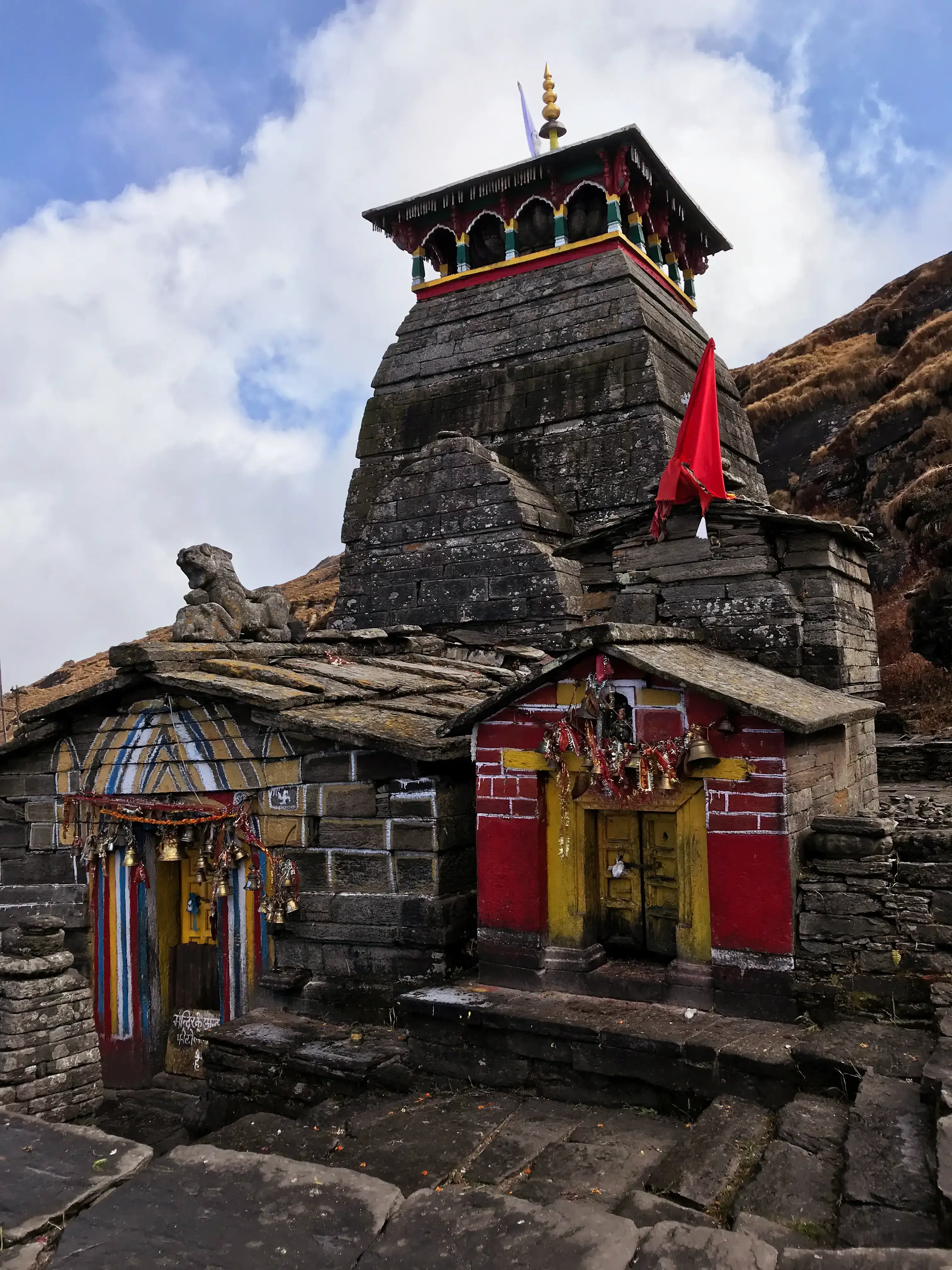
Temple Timings, Rituals & What to Expect Upon Arrival
Visiting Tungnath Temple is a truly unique experience, blending the physical challenge of a Himalayan trek with deep spiritual devotion. Understanding the temple timings, rituals, and what to expect upon your arrival will help you make the most of your sacred journey.
Temple Timings:
Tungnath Temple is typically open for pilgrims for about six months a year, as heavy snowfall makes it inaccessible during winter.
-
Opening Date: The temple generally opens around the end of April or the beginning of May, usually around the auspicious festival of Akshaya Tritiya. For 2025, the tentative opening date is May 2nd. A special "Utsav Doli" (palanquin procession) carries the idol of Lord Shiva from its winter seat in Makkumath village up to Tungnath a few days before the official opening.
-
Closing Date: The temple usually closes around early November, after the Diwali festival. The idol is then moved back to Makkumath for the winter months, where daily worship continues.
-
Daily Timings (when open): Generally, the temple remains open from 6:00 AM to 7:00 PM during its operational season. It's always a good idea to start your trek early in the morning to reach the temple, offer your prayers, and then trek to Chandrashila Peak, allowing ample time for the descent before it gets dark.
Rituals & Ceremonies:
Upon arrival at Tungnath Temple, you'll feel a palpable sense of devotion and peace.
-
Daily Pujas: Throughout the day, priests perform various rituals and pujas (worship ceremonies) dedicated to Lord Shiva. These often include chanting of Vedic mantras, offering of bilva leaves (sacred to Shiva), milk, honey, and flowers.
-
Aarti: The evening aarti (ceremonial waving of lamps) is a particularly beautiful and spiritually uplifting experience.
-
Simple Devotion: The temple's ancient and simple stone structure creates an environment that encourages quiet reflection and personal prayer. You'll see devotees performing their own quiet rituals.
-
Special Ceremonies: The opening and closing ceremonies are elaborate and very significant, drawing many locals and pilgrims. These events involve processions, traditional music, and special pujas.
What to Expect Upon Arrival:
-
Awe-Inspiring Location: Your first impression will likely be one of awe. The temple stands against a stunning backdrop of snow-capped peaks, making its elevated position feel truly divine.
-
Humble Structure: Despite its immense spiritual significance, the temple is not a grand, sprawling complex. It's a relatively small, ancient stone structure, exuding a sense of timelessness and humility.
-
Spiritual Energy: You'll immediately feel a strong spiritual energy and peaceful atmosphere. The air is pure, and the quietness (broken only by temple bells and chants) is profound.
-
Priests and Devotees: You'll see the temple priests performing their duties and many fellow pilgrims who have undertaken the same challenging trek. There might be small shops or stalls selling offerings (flowers, incense) or refreshments.
-
Basic Facilities: Remember, you are at a high altitude in a remote area. Facilities around the temple are very basic. There might be small tea stalls or simple eateries offering Maggi noodles, tea, and basic meals. Public restrooms might be rudimentary.
-
Weather Changes: Be prepared for sudden changes in weather, even during the "open" season. It can be sunny one moment and cloudy or chilly the next.
-
Photography: While you can take photos of the temple exterior and surroundings, photography is generally prohibited inside the main shrine. Always respect the sanctity of the place.
The trek to Tungnath is as much a spiritual journey as a physical one. Upon arrival, take a moment to absorb the unique blend of natural grandeur and profound devotion that defines this highest Shiva temple.

Chandrashila Trek Beyond Tungnath – A Heavenly Extension
After conquering the spiritual heights of Tungnath Temple, many trekkers extend their journey to the ultimate vantage point: Chandrashila Peak. This additional climb is a heavenly extension, offering views that truly make you feel like you're on top of the world. The chandrashila trek is widely considered the crown jewel of the region, providing an unparalleled panoramic spectacle of the Himalayan range.
The path from Tungnath to Chandrashila is a relatively shorter but steeper ascent, adding to the challenge and the reward. Standing at an elevation of approximately 4,000 meters (13,000 feet), the chandrashila summit trek is an experience of pure awe.
-
The Final Ascent:
-
Distance and Time: From Tungnath Temple, the chandrashila trek is about 1.5 kilometers (less than a mile) and usually takes an additional 45 minutes to 1 hour to reach the summit. While short, it's a consistent uphill climb.
-
Trail: The trail can be rocky and, during winter months, covered in snow, making it a bit more challenging. However, it's generally well-defined.
-
Effort and Reward: The extra effort required for this final stretch is immensely rewarding. Each step upwards brings you closer to a view that will stay with you forever.
-
-
The Heavenly Views from the Summit:
-
360-Degree Panorama: From the chandrashila summit trek, you are greeted with a breathtaking 360-degree view of the majestic Himalayas. It's like standing on a colossal natural balcony.
-
Iconic Peaks: You can clearly see prominent peaks like Nanda Devi, Trishul, Chaukhamba, Kedarnath, Kedar Dome, Bandarpunch, and many more, stretching across the horizon in every direction.
-
Sunrise Magic: Many trekkers aim to reach the chandrashila summit trek for sunrise. Witnessing the first rays of the sun paint the snow-capped peaks in hues of gold, orange, and pink is a truly spiritual and unforgettable moment. This is often the highlight of any chopta chandrashila trek.
-
Sense of Accomplishment: Reaching the summit after the climb instills a profound sense of accomplishment, enhanced by the sheer beauty of the surrounding landscape.
-
-
Myths and Serenity:
-
Lord Rama's Meditation: Legends say that Lord Rama meditated on Chandrashila Peak after defeating the demon king Ravana, adding to the spiritual significance of the spot.
-
Peaceful Atmosphere: Despite its popularity, the summit maintains a profound sense of peace and tranquility, allowing you to connect deeply with the vastness of nature and the spiritual energy of the place.
-
The chopta chandrashila trek is not just a physical journey but a journey of the soul, culminating in a celestial experience where the mountains open up to reveal their true grandeur.

Best Time to Visit Tungnath for Trekking and Temple Darshan
Choosing the perfect time for your chopta tungnath trek from delhi or chopta chandrashila trek from delhi is key to an unforgettable experience. The best period combines pleasant weather for trekking with clear skies for those incredible Himalayan views and access to the temple.
Here are the ideal times to visit Tungnath for trekking and temple darshan:
1. Spring/Early Summer (May to Mid-June): Highly Recommended
-
Why it's Best: This is often considered the most popular and ideal time for the chandrashila trek from delhi.
-
Temple Access: The Tungnath Temple is accessible to pilgrims during this period.
-
Pleasant Weather: Days are comfortably warm and sunny, perfect for trekking. Temperatures in Chopta range from roughly 6°C to 24°C in May. Nights are cool but manageable.
-
Lush Greenery & Blooms: The entire region, especially Chopta and the trekking trail, is vibrant with fresh green meadows and blooming rhododendron flowers, creating a truly picturesque landscape.
-
Clear Views: Skies are generally clear, offering excellent visibility of the surrounding peaks, though some haze can occur, especially in late June.
-
Accessible Trails: The trekking trails are usually free of snow (except for small patches at higher altitudes like Chandrashila in early May) and are in good condition.
-
2. Autumn (October to Mid-November): Highly Recommended
-
Why it's Best: This period offers a different but equally stunning experience, making it another top choice for your chopta tungnath trek from delhi.
-
Post-Monsoon Clarity: After the monsoon rains, the atmosphere is incredibly clear. This means you get the sharpest, most breathtaking views of the mighty Himalayan peaks.
-
Crisp Air & Comfortable Temperatures: The weather is cool and invigorating, ideal for long treks. Daytime temperatures in Chopta range from about 2°C to 17°C in October. Nights get quite chilly, so pack warm clothes.
-
Golden Hues: The foliage in the forests starts to turn golden and russet, adding beautiful colors to the landscape.
-
Fewer Crowds: Generally, autumn sees fewer crowds compared to the peak summer months, allowing for a more peaceful and serene trekking and darshan experience.
-
Temple Access: Tungnath Temple is accessible during this period.
-
Times to Consider (with things to know):
-
Winter (Mid-December to February/Early March):
-
Snow Lovers' Paradise: If seeing heavy snow is your main goal and you are an experienced trekker, winter offers a magical, snow-covered landscape. The chandrashila trek from delhi becomes a proper snow trek.
-
Challenges: However, the trek becomes much more difficult and risky due to heavy snow. Tungnath Temple is closed for worship in its high-altitude location during winter. Roads to Chopta can be blocked by snow, requiring a longer trek from lower villages. This is best for experienced trekkers prepared for extreme cold and challenging conditions.
-
-
Monsoon (July to September):
-
Lush Greenery: The region is incredibly vibrant and green due to the rains.
-
Not Recommended for Views & Safety: Heavy rainfall can lead to slippery trails, landslides, and road blockages, making travel hazardous. Views are often obscured by mist and clouds. The trek can be very challenging and uncomfortable. It's generally advisable to avoid this period if clear views and safety are your priorities.
-
In summary, for the most comfortable trekking conditions, clear mountain views, and temple access, plan your chopta tungnath trek from delhi or chopta chandrashila trek from delhi during May-June or October-November.
Wildflowers, Snow, Silence – What You See on the Trail
The trek to Tungnath and Chandrashila offers a changing canvas of nature's beauty, constantly surprising you with its sights, sounds, and feel. When you plan a tungnath chandrashila trek from delhi, what you experience on the trail itself becomes a huge part of the adventure.
Wildflowers in Spring and Early Summer:
-
A Burst of Color: If you visit in May and early June, the trekking paths, especially in the lower parts, burst into life with bright colors. The most famous flowers are the rhododendrons, which bloom in shades of red, pink, and white. These make the paths look like colorful tunnels, especially beautiful after the cold winter.
-
Many Kinds of Flowers: Besides rhododendrons, you'll see many other small wild flowers pushing through the ground. The meadows around Chopta and even higher up towards Tungnath become covered in these lovely blooms. The air during this time feels fresh and smells sweet.
-
Green Everywhere: The open fields are at their greenest, with fresh grass covering the hillsides. This creates truly beautiful scenes against the backdrop of the huge mountains.
Snow in Winter and Early Spring:
-
Winter Wonderland: During the coldest months (late December to February), the entire tungnath chandrashila trek from delhi route gets covered in a thick blanket of snow. The whole area turns into a magical, pure white landscape.
-
Challenging but Worth It: Walking in snow needs special gear and some experience, but the sights are amazing. Trees are heavy with snow, and everything sparkles under the winter sun.
-
Leftover Snow in May: Even in early May, especially on the steeper part leading to Chandrashila, you might still find patches of snow that are left over from winter. This adds an exciting challenge to your trek.
Profound Silence Throughout the Year:
-
Nature's Music: One of the most striking things you'll notice on the trail, no matter when you visit, is the deep silence. Far away from the honking horns and chatter of cities, you'll find a quietness that is only broken by the sounds of nature.
-
Sounds of the Wild: If you listen carefully, you might hear the rustling of leaves, the quiet call of a bird (like the shy Monal pheasant early in the morning), or the gentle sound of a small stream.
-
Inner Peace: This deep quietness helps you think clearly and feel a stronger connection with everything around you. It's a big reason why many people find the tungnath chandrashila trek from delhi to be not just a walk, but a journey for their mind and soul, bringing a feeling of calm and clarity.
So, whether you are drawn by the bright wildflowers of spring, the calm beauty of fresh snow, or the deep silence of the mountains, the trail to Tungnath and Chandrashila always offers something special and changing for every visitor.
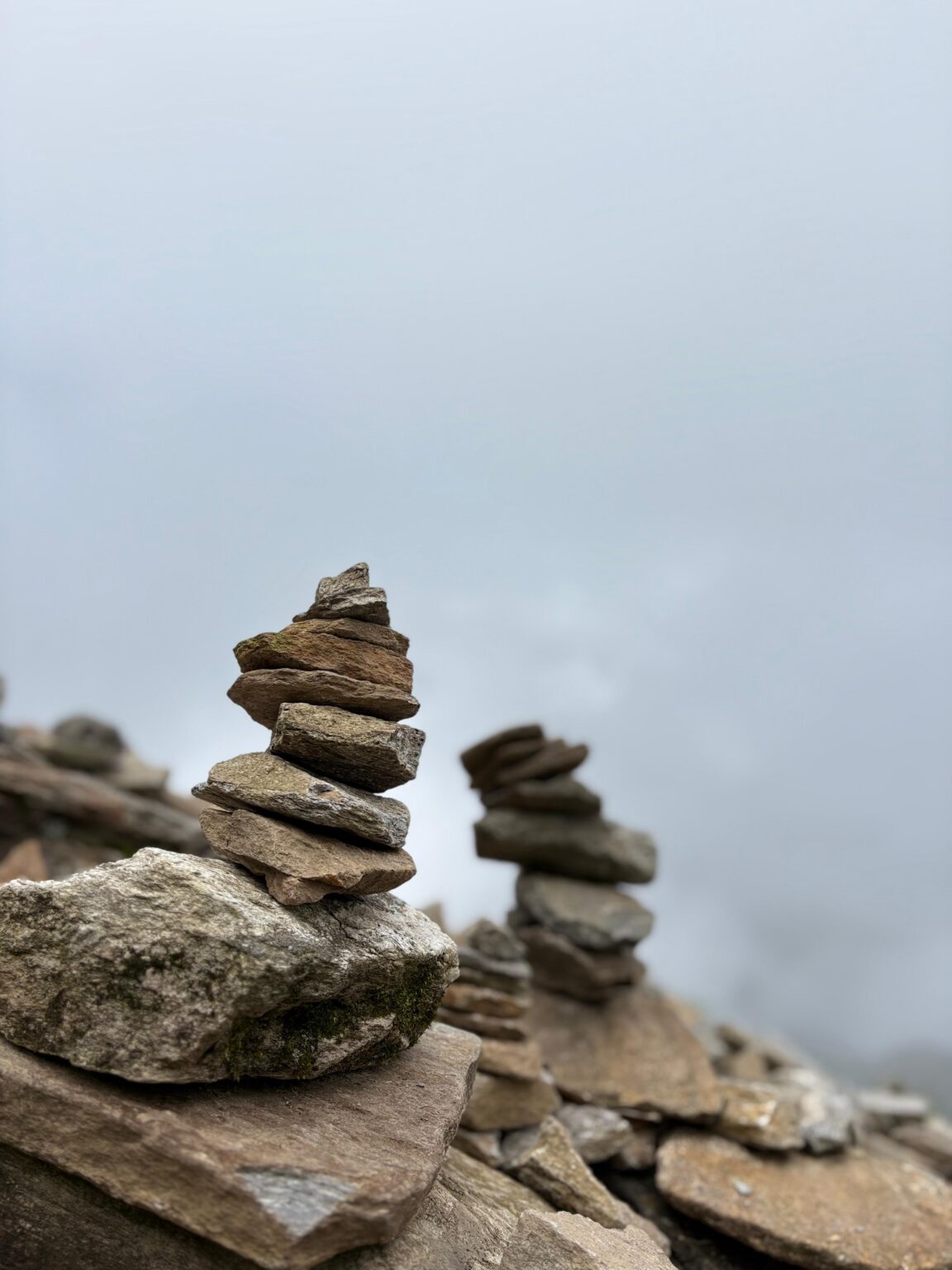
Nearby Places to Explore Around Chopta and Tungnath
While the chopta tungnath trek package and the chopta tour packages themselves offer incredible beauty, the region around Chopta and Tungnath is full of other amazing spots worth exploring. Adding these places to your tungnath chandrashila trek from delhi can make your trip even more memorable.
Here are some nearby places you should consider exploring:
-
Deoria Tal (Lake): A Peaceful Reflection
-
Just a short and relatively easy trek from Sari village (which is a quick drive from Chopta), Deoria Tal is a beautiful, calm lake.
-
What you'll see: On clear days, the lake offers stunning reflections of grand Himalayan peaks like Chaukhamba in its calm waters. It's a truly magical sight, especially at sunrise or sunset.
-
Activities: You can enjoy camping by the lake (with permits), birdwatching, and simply soaking in the peaceful atmosphere. It's a great spot for photography.
-
-
Ukhimath: The Winter Home of Gods
-
Located about 30 km from Chopta, Ukhimath is a significant religious town.
-
What you'll see: During winter months when the main Kedarnath and Tungnath temples are closed due to snow, the idols are brought down to Ukhimath's Omkareshwar Temple for worship. This makes it an important pilgrimage site year-round.
-
Experience: You can visit the ancient temple, see the winter celebrations, and enjoy the local culture of this charming town.
-
-
Kanchula Kharak Musk Deer Sanctuary: A Walk in Nature
-
Around 7 km from Chopta, this sanctuary is a dense forest area aimed at protecting the rare musk deer and other Himalayan wildlife.
-
What you'll see: While spotting a musk deer can be tricky, the sanctuary offers wonderful opportunities for nature walks and birdwatching. It's a peaceful place to immerse yourself in the natural forest environment.
-
-
Rohini Bugyal (Meadow): Hidden Gem
-
This beautiful meadow is often visited as part of the trek from Deoria Tal towards Chopta.
-
What you'll see: Rohini Bugyal is a lush green meadow surrounded by thick forests of pine, deodar, and rhododendron. It's a wonderful spot to relax, have a picnic, or even camp if you're doing a longer trek. It offers lovely views and a quiet atmosphere.
-
-
Sari Village: Base for Deoria Tal
-
This small, charming village is the starting point for the trek to Deoria Tal.
-
What you'll see: Sari offers a glimpse into local Garhwali life. You can interact with the friendly villagers, enjoy simple local food, and take in the serene rural setting before or after your trek to the lake.
-
These nearby places offer a mix of spiritual sites, natural beauty, and a chance to experience the local culture, adding richness to any chopta tour packages or chopta tungnath trek package you choose.
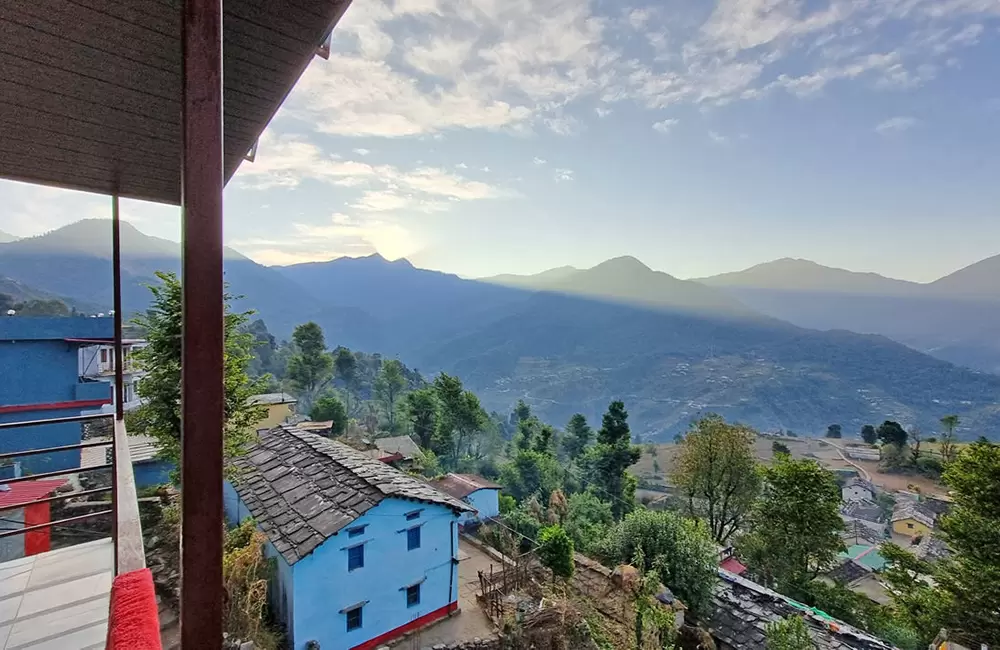
Book Your Tungnath Temple Trekking Package Today
If you're ready to experience the incredible Tungnath Temple Trek and explore the beautiful Chopta region, TourMyHoliday offers well-planned packages to make your adventure seamless and enjoyable.
To Book Your Tungnath Temple Trekking Package Today with TourMyHoliday, here are their contact details:
-
Phone/WhatsApp: +91-9990055699
-
Email: info@tourmyholiday.com
-
Website: www.tourmyholiday.com
You can visit their website directly or contact them via phone or email to inquire about their Chopta Tungnath Trek from Delhi packages or Chopta Chandrashila Trek from Delhi options. They often provide detailed itineraries, package prices, and departure dates to help you plan your ideal Himalayan getaway.
Frequently Asked Questions:
1. What is the best time to visit Chopta for trekking and snow?
Answer: For snow lovers, December to February is ideal. For trekking, March to June and September to November offer the best weather and clear trails.
2. Is the Chopta Tungnath Trek suitable for beginners?
Answer: Yes, it’s perfect for beginners! The trek is moderate in difficulty with gradual inclines and scenic views all along.
3. What is the cost of a budget Chopta tour package under ₹6000?
Answer: With TourMyHoliday, you can get a complete 2N/3D Chopta tour package under ₹6000 including stay, meals, and guide.
4. How far is the Chandrashila summit from Tungnath Temple?
Answer: The Chandrashila summit is about 1.5 km uphill from Tungnath, and takes around 45 minutes to 1 hour to reach.
5. Are there luxury stays available in Chopta?
Answer: Yes, apart from budget camps, there are luxury eco-resorts and premium cottages available with warm hospitality and mountain views.
6. What is the Chopta Chandrashila trek distance from Delhi?
Answer: The distance from Delhi to Chopta is around 450 km, and the trek from Chopta to Chandrashila via Tungnath is about 5 km (one way).
7. Can I get snowfall during a Chopta tour package from Delhi?
Answer: Yes, if you travel between late December and February, you can enjoy snowfall even with a weekend Chopta package from Delhi.
8. Is there mobile network in Chopta?
Answer: Limited. BSNL and Jio work in patches. Prepare for a digital detox amidst nature!
9. How cold does it get in Chopta during winter?
Answer: Temperatures can drop as low as -10°C to -15°C in peak winter, so carry proper woollens and thermal gear.
10. What makes TourMyHoliday Chopta tour package special?
Answer: We offer custom itineraries, local guides, stays with views, and both budget and premium packages with all essential comforts.
